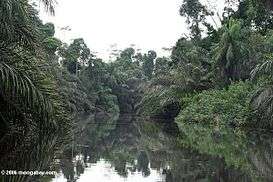Archaeology of Central Africa


Central Africa is generally considered to encompass ten countries (Cameroon, south-Chad, Central African Republic (CAR), Equatorial Guinea, Republic of the Congo, Gabon, Democratic Republic of the Congo (DRC), Rwanda, Burundi, Angola [1]) which amounts to more than 6 million square kilometers or roughly the size of the United States west of the Mississippi River (Maret). Despite its large size, very little archaeological research has been done in the region.
Beginning research
Archaeological research has been scare in Central Africa. One reason is that half of Central Africa is covered by rainforest. Because of this many archaeologists believed prehistoric occupation was improbable and, if there had been, preservation would be low. Because of the rainforest and the poverty in the area, infrastructure is “non-existent or dilapidated” which makes traveling to possible sites difficult. Central Africa has also had high outbreaks of deadly diseases like AIDS and Ebola fever fever and has also experienced numerous “coups d’etat, prolonged civil wars, and even genocide”.[1] The first archaeological research was completed in the early 1900s. Modern studies began in the 1960s, and more systematic studies were completed from 1980-1990. The most recent research has been focusing on creating a regional chronology[2]
Early habitation
Archaeologists questioned if humans could survive only on forest resources before the emergence of agriculture. Research done by Els Cornelissen et al suggests that occupation was possible before agriculture and may have actually been very hospitable. Because of the ecodiversity of the area, the people inhabiting the area would have had access to a variety of resources, making it a more stable environment to live in.[3]
Evidence of some of the earliest inhabitants was found in 1982 and 1983 by J. Preuss at Bikoro in the Democratic Republic of the Congo. Preuss found a number of stone artifacts including projectile points, “segments, cores, flakes, and unmodified waste”.[4] These artifacts would have been used by hunter-gatherers and are estimated to have been made during the Late Stone Age between 12,000-3,000 years BP.
More research in the 1980s found picks, choppers and, hand-axes representative of the Middle Stone Age. Clist argues that these tools could be 40,000 years old, meaning humans have been occupying the area for at least 40,000 years.[5]
More recently, James Denbow, excavated and dated sites on the Loango Coast between Gabon and Cabinda. He dated sites only as early as approximately 3250 BP- 2050 BP. These 10 sites "produced only lithic debris... were very small and contained concentrations of chert flakes and fragments." [6]
Gray Sand
Gray Sand is a pre-ceramic Later Stone Age (LSA) site that is located 10 kilometers north of Kouilou. This site dates to approximately 3342-2888 BP. This site was a non-ceramic LSA site where archaeologists recovered "42 chert and 265 quartzite flakes and fragments [but] no formal stone tools..." The quartzite could be locally found but the chert could have only been found approximately 50 kilometers east in the Mayombe Mountains. Chert made up almost 14 percent of lithics found at the site which indicates that people living at Gray Sand had interactions or territories as far as the Mayombe Mountains. Later lithic material, from approximately 2461-2147, was found in the stratigraphy above the LSA lithics which showed a preference for local quartzite.[6]
Transition to neolithic
The Late Stone age in Central Africa ended approximately 3,500 years BP. By 3,5000 - 3,000 years BP, the climate and the environment had changed as well as the peoples and practices of peoples inhabiting the region. A shift from rainforest to savanna created an opportune environment for farming.[2]
Oslisly et al suggests that by approximately 3,500 BP the hunter gatherers living in Central Africa were pushed out by agricultural migrants from the north. These early agriculturalists are differentiated by dug garbage pits which differs from waste practices of earlier inhabitants. During the Neolithic phase, 3500–2000 years BP, “new technologies such as pottery and stone polishing” are developed and mastered. The presence of stone hoes indicates that the new inhabitants were farming.[2]
References
- 1 2 Stahl, Ann (2005). African Archaeology. Blackwell Publishing. p. 421. ISBN 9781405101561.
- 1 2 3 Oslisly, Richard; White, Lee; Bentaleb, Ilham; Favier, Charly; Fontugne, Michel; Gillet, Jean-François; Sebag, David (2013-09-05). "Climatic and cultural changes in the west Congo Basin forests over the past 5000 years". Phil. Trans. R. Soc. B. 368 (1625): 20120304. doi:10.1098/rstb.2012.0304. ISSN 0962-8436. PMC 3720025
 . PMID 23878334.
. PMID 23878334. - ↑ Cornelissen, Els (September 2002). "Human Responses to Changing Environments in Central Africa Between 40,000 and 12,000 B.P". Journal of World Prehistory. 16 (3): 197–235. doi:10.1023/A:1020949501304.
- ↑ Eggert (1992). "The Central African Rain Forest: Historical Speculation and Archaeological Fact". World Archaeology. 24 (1): 1–24.
- ↑ Clist (1989). "Archaeology in Gabon". The African Archaeological Review. 7: 59–95.
- 1 2 Denbrow, James (2014). The Archaeology and Ethnography of Central Africa. New York, NY: Cambridge University Press.